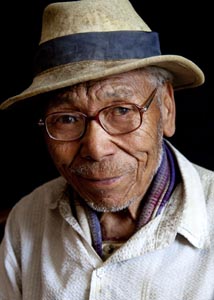Name: Sonam
(Alias: Yes)
Gender: Male
Interview Age: 78
Date of Birth: 1934
Birthplace: Kongpo, Utsang, Tibet
Year Left Tibet: 1959
Profession: Farming, Nomad
Monk/Nun: Previously
Political Prisoner: No

Interview No.: 23D
Date: 2012-05-16
Language: Tibetan
Location: Mcleod Ganj, Dharamsala, Himachal Pradesh, India
Categories: Chinese Invasion and Occupation
Keywords: childhood memories, Chinese -- first appearance of, environment/wildlife, farm life, herding, refugee in India -- life as, resistance fighters, servitude, Utsang
Summary:
Sonam was born into a large family with 11 siblings. He describes being a samadok 'farmer and herder,' cultivating lands in springtime and going up the mountains with the animals during the summer months. He recalls herding animals since the age of 7 or 8 and he knows the whole process of milking and preparing cheese and butter. He gives a detailed account of the many wild animals that were present in the mountains and also describes a rarely seen animal, the migoe 'ape/gorilla/yeti.'
Sonam's father died when he was young and he became a servant to other families because his mother had a difficult time supporting all the children. He was 14 years old when the Chinese appeared in Tibet and he noticed they looked very poor. They requested food, clothing and animals to transport their weapons.
Sonam became a monk at Gaden Monastery but stayed only two years until the uprising took place in 1959. The monks tried to defend themselves but were overpowered and fled. He joined the resistance group, fighting the Chinese for two months at Tsethang in Lhoka. After coming into exile in India, Sonam joined the Establishment 22 unit of the Indian Army and served it for 22 years. He narrates various experiences, including fighting in Bangladesh war in 1971. He also served as headman of the Ngapa Division in Dharamsala for 16 years.
Interview Team:
- Rebecca Novick (Interviewer)
- Ronny Novick (Videographer)
- Thupten Kelsang Dakpa (Interpreter)

